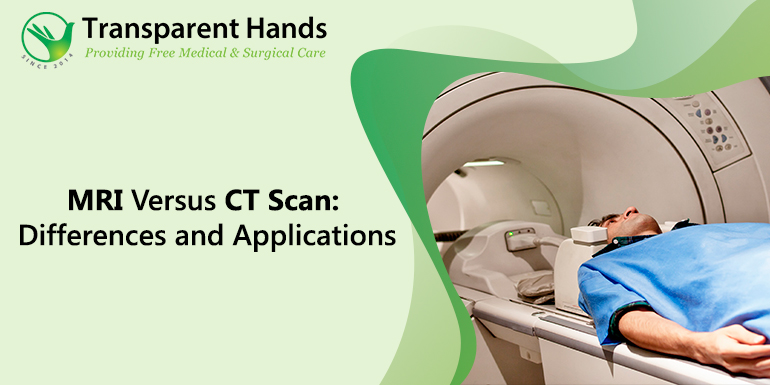MRI Versus CT Scan: Differences and Applications

MRI (Magnetic Resonance Imaging) versus CT scan (Computed Tomography) is a radiological diagnostic intervention used to capture images of internal body parts. The key difference between the two technologies is that an MRI uses radio waves while a CT scan uses X-rays. Since both technologies use different waves to capture images of the body, their applications and costs are different. Let’s take a look at them.
CT Scans (Computed Tomography)
A Computed Tomography (CT) Scan is essentially an advanced form of X-Ray imaging. The machine uses X-Rays to take multiple 2D images of certain parts of the body. These pictures are processed in a computer that stacks 2D images to produce a 3D image of the structure under examination. It reveals more details, provides a better view, and helps the physician to precisely understand the anomalies.
Application of CT scans
CT scans have multiple applications and the physician may advise them to get a detailed view of multiple structures and organs of the body. These can include but are not limited to:
- Diagnosis of muscle and bone disorders
- Locate tumors
- Monitor the spread of cancer
- Detect internal injuries
- Detect internal bleeding and clots
- Guide certain procedures i.e., biopsies, angioplasty, aneurysm repair
When are CT scans preferred?
CT scans are the preferred radiological intervention in certain cases because they:
Deliver Results Faster
CT scans are preferred in emergencies because they can provide the images faster. On average a CT scan takes about 10-30 minutes depending on type of machine and area under examination. When health professionals cannot afford to lose time, CT scans can come to the rescue.
They are used to differentiate between ischemic and hemorrhagic strokes. Internal bleedings following road traffic accidents can also be detected via CT scans. Furthermore, clots can be identified and resolved quickly with the help of CT scans.
CT Scans Can Be Used for Patients with Metallic Implants
Patients that have undergone orthopedic procedures may have metallic implants in their bodies. These implants can be in the form of screws and rods used to hold the bones in place. MRI scan cannot be used for such patients because of magnetic resonance. Hence, the physicians prefer CT scan to minimize the risks in such cases.
More Affordable
When highly detailed images are not required, physicians may advise CT scans, which are significantly cheaper than MRIs.
Risks of CT scans
CT scans are generally considered very safe but there are some risks nonetheless. These include:
DNA Mutation
Since CT scans use X-Rays, which are ionizing radiations, there is a risk of DNA mutation which can lead to some health problems including cancers. However, the chances of such an occurrence are very low. The risk increases if CT scans are done very often, which is why you must seek professional advice before undergoing these scans.
Allergic Reactions
For some conditions, like detection of lesions, clots and stenosis of arteries, physicians may advise CT scans with contrasts. Following the injection of the contrast, some patients may experience an allergic reaction. Radiological teams anticipate the risk and take adequate measures to reduce and manage such reactions.
MRI (Magnetic Resonance Imaging)
MRI scans are also used to capture images of internal body structures. These images are much more detailed compared to the ones we get from CT scans. MRI scans use strong magnetic fields and radio waves to produce detailed high-resolution images.
Applications of MRI scans
MRI scans are used to diagnose anomalies in:
- Heart and blood vessels
- Brain and spinal cord
- Internal organs i.e., liver, prostate gland, ovaries, pancreas, etc.
- Breasts
- Small bones and joints
- As well as many other parts of the body
When are MRI scans Preferred?
MRI scans provide much better details of internal body structures compared to CT scans. Doctors use MRI scans to diagnose problems that cannot be detected with CT scans. These include:
Blood Vessel Irregularities
Vascular abnormalities can happen because of a number of reasons. These anomalies are usually too small to be seen using CT scans. Physicians may advise an MRI scan if the patient is suspected to have such a condition.
Internal Bone Structure
While CT scans provide a clear view of bones, they are not particularly good for examining the morphology of bones. To look at internal body parts like bone marrow and structures that connect bones with muscles, including tendons, physicians usually advise MRI scans.
Brain Problems
The brain is a complex organ and it has some areas that remain hidden in images produced by CT scans. Out of these areas, the most common one is the brain stem, which controls the autonomic system of our bodies. Before making any interventions in such a critical area of the brain, it is important for surgeons to have a detailed view of it. MRI scans are used to get these detailed images of the brain.
Risks of MRI Scans
MRIs are considered as one of the safest radiological interventions and do not pose the risk of DNA mutations like CT scans and X-rays. Patients only experience problems when they have metallic implants inside the body. Technicians ask patients to remove all metallic objects, including jewelry, before the scan. They also ask patients if they have any metallic implants in their body.
Bottom Line of MRI Versus CT Scan
MRI and CT scans are important diagnostic tests with multiple applications. However, they can be expensive, which is why Transparent Hands supports deserving patients who need these scans. We need your generous donations to provide quality health care, including diagnostic tests and surgeries, to patients belonging to underprivileged communities. Donate to this cause now.










Leave Your Comments